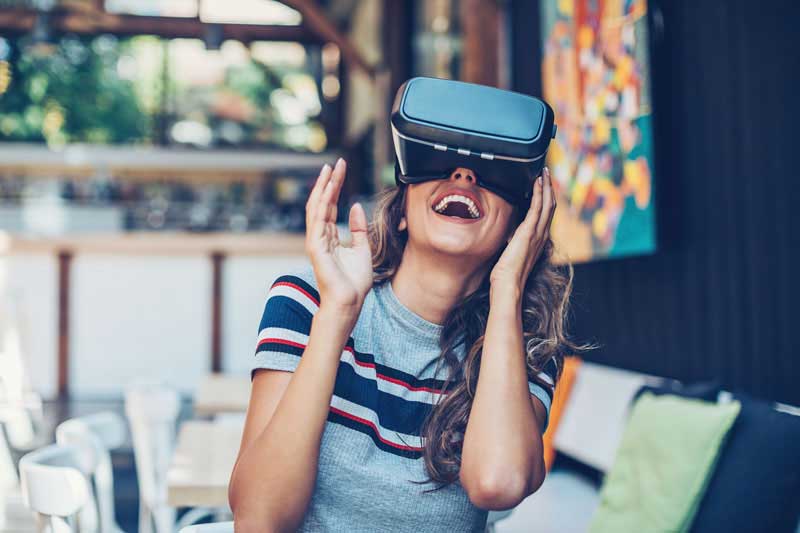Technology is constantly changing, and companies must evolve or get left behind. For years, concepts such as virtual reality (VR) seemed like the stuff of science fiction rather than a part of our daily lives. Let’s explore Augmented Reality Impact on Web Design.
However, recent advances have changed the playing field, making VR more affordable and accessible. Oculus Rift, a VR headset, has allowed more people to experience VR applications through smartphones, tablets, and desktops. Google Fiber introduced faster and more reliable broadband capability, improving access to VR technology for the general public.
However, before we can explore how virtual reality will impact the future of web design, we must first define VR.
Augmented Reality Impact on Web Design
What are Virtual Reality and Augmented Reality?
British science writer Chris Woodford describes VR as “A believable, interactive 3D computer-created world that you can explore so you feel you are there, both mentally and physically.”
In contrast, Augmented Reality (AR) is grounded in your actual environment. Computer scientist and AR expert Ronald Azuma define AR as an application that “combines the real world with the virtual world, is interactive and in real-time, and is registered in 3 dimensions.”
With the current technology, VR relies on wearable tech such as headsets. While AR often utilizes these items, it does not rely on them.
How is Augmented Reality Currently Used?
Although we are in the early phases of AR adoption, many companies are already dipping their toes in the water.
• Facebook bought Oculus Rift for 2 billion dollars and planned to integrate it’s use into their current app to provide a more immersive experience.
• MSC Cruise Line has recently launched the first “smart cruise ship”, the Meraviglia. Passengers utilize AR in the many shops to virtually try on clothes and accessories.
• Apple acquired Metaio, an augmented reality software company based in Germany. This leads many to believe the company has VR and AR plans in the works.
• Wayray offers holographic navigation tools that display GPS information directly onto your car’s windshield. No need for headgear.
• AccuVein allows medical professionals to see veins for easier blood draws and IV access.
Implications for Web Design
Cultural anthropologists believe we will continue to use items that are already a part of our daily lives, but those items will now become “smart”. Just like smartphones and smart cars, we will interact with “smart parking meters”, “smart refrigerators”, and more. Therefore, the emphasis is not on designing new devices but on the applications and websites for interacting with our current devices.
Companies are already exploring their web-based options. VR browser, Janus VR, allows you to walk through a lobby, and pass through doors to visit specific websites where text appears on walls and videos are shown in theatres. You can even interact with other people visiting the site. Mozilla is developing Firefox experiments with support for VR apps. And Google is said to be experimenting with VR browsing.
A new application called Layar uses the camera on your iPhone or Android device to display information about what is around you or printed material in front of you. It also allows you to interact with that information.
The Future
Although it isn’t exactly clear where this movement will lead, it is safe to bet that web design will include some form of VR and AR. It’s too early to invest significant sums of money, but companies should closely follow updates in the tech and be ready to adapt their web content. Specific areas for attention include responsive website design, 3D modelling, and VR/AR tech. Don’t get caught napping.
For more guidance and advice on web design for your organization, please contact us.
Let Pixel Fish take your business to the next level with a Stunning Business Website.
Check out some of our latest Website Design projects and Testimonials.
Further Information:
12 Tactics to Increase WordPress Website Speed
8 Top WordPress Security Plugins for Business Websites
10 Plugins that Showcase the Versatility of WordPress Website Design
7 Strategic Mobile Responsive Website Design Benefits
10 Signs Your Outdated Website Should Be Upgraded to WordPress
10 Ways to Improve Your Search Ranking for Your WordPress Website
WordPress Website Image Best Practices for SEO, Speed and Engagement
9 Essential Website Features for Remote Users
12 WordPress Web Design Tips for Small Businesses
10 Best Practices for a Successful WordPress Website Design Project
Top 8 Advanced WordPress Features and Plugins to Beat Your Competition



